|
Mrs Sonia Gandhi, Chairperson
of the NAC today inaugurated Anish Kapoor’s first
ever exhibition in India. The exhibition is being
held at the National Gallery of Modern Art in New
Delhi and at Mehboob Studios in Mumbai. This is the
biggest exhibition of Anish Kapoor’s work ever shown
overseas.
The exhibition is being presented by the Ministry of
Culture, Government of India and National Gallery of
Modern Art India, British Council and Lisson
Gallery, in association with Louis Vuitton and the
Tata Group.
Kapoor’s unique style and Indian heritage have
combined to make him one of the most engaging and
distinctive artists in the world and the exhibition
will be the first ever showcase of his work in the
country of his birth. The exhibition will be
organised over two sites in New Delhi and Mumbai and
is the largest and most ambitious exhibition project
ever to be presented. It features work and
sculptures spanning the breadth of the artist’s
career, from his early pigment-based sculptures of
the 1980s to his most recent works in polished steel
and in wax.
The exhibitions will be displayed in two venues: the
newly renovated NGMA, New Delhi (Anish Kapoor show
will be the first major exhibition to be held in the
gallery’s newly constructed Exhibition Hall); and
the Mehboob Studios, Bandra, Mumbai. Each exhibition
will focus on a different strand of Kapoor’s
practice, with each show complementing the other to
form an overall picture of the diversity and energy
within his oeuvre. Both exhibitions will feature
works which were included in the recent,
record-breaking exhibition of Kapoor’s work at the
Royal Academy, London, which attracted over 275,000
visitors in less than three months.
“I am delighted that what we had been dreaming of
for the past nine years has finally come to
fruition. The Kapoor exhibition is one of the
largest projects we have done since the Picasso
exhibition in 2001, not just in its scale of the
actual works, but also in terms of the international
stature of the artist, including partnerships
amongst various organisations, and its outreach,”
Prof. Rajeev Lochan, Director of the NGMA said.
Ruth Gee, Regional Director British Council says,
“We are delighted to have played a part in creating
this milestone exhibition in Delhi and Mumbai. It is
a proud moment in our cultural relationship with
India”.
The Anish Kapoor exhibitions will coincide with the
India Art Summit, which runs from 20-23 January
2011, and attracts approximately 40,000 visitors
annually.
Smt. Sonia Gandhi's inaugural
address
List of works
1. DELHI
To reflect an intimate part of the red
1981,
mixed media and pigment,
200 x 800 x 800 cm
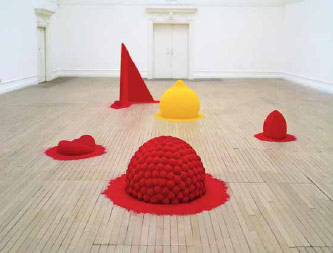 As an art student Anish Kapoor made assemblages, did
performances and drew on the floor with chalk. In
all this there was a fascination with the
two-dimensional arts: with painting, but also
tapestries, relief carving, calligraphy, and Persian
carpets. In 1979, his studies complete, Kapoor made
a three week trip back to India, where piles of raw
pigment in markets, by roadside shines and doors to
temples made a big impression. Back in his London
studio, Kapoor began a series of drawings where red
shapes were spangled across the paper, then used
pure pigment to turn the motifs into
three-dimensional forms. They are covered with a
generous dusting of pigment, which spills onto the
floor like a halo, radiating a powerful sense of
that which is most forbidden in museums and
galleries: touch. As an art student Anish Kapoor made assemblages, did
performances and drew on the floor with chalk. In
all this there was a fascination with the
two-dimensional arts: with painting, but also
tapestries, relief carving, calligraphy, and Persian
carpets. In 1979, his studies complete, Kapoor made
a three week trip back to India, where piles of raw
pigment in markets, by roadside shines and doors to
temples made a big impression. Back in his London
studio, Kapoor began a series of drawings where red
shapes were spangled across the paper, then used
pure pigment to turn the motifs into
three-dimensional forms. They are covered with a
generous dusting of pigment, which spills onto the
floor like a halo, radiating a powerful sense of
that which is most forbidden in museums and
galleries: touch.
To reflect an intimate part of the red draws a fuzzy
line between abstraction and narrative. The shapes
are rich in association (perhaps seed pod, breast,
mosque dome or ziggurat), but they are not
descriptive: Kapoor is pointing towards bigger
ideas. It is as if the motifs in a Persian carpet
have been brought to life, and emerge from the
floor, like clues to something beyond. Spaced
proportionally from each other, there is room for
the eye to wander between the separate elements, and
a necessity to walk around them. There is an
emphasis on the spaces ‘in-between’.
2. DELHI
Untitled
1992,
sandstone and pigment,
230 x 122 x 103 cm
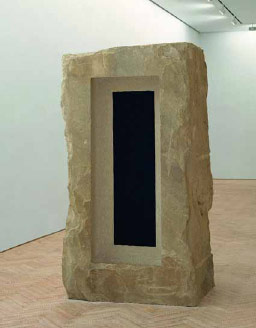 Kapoor’s pigment works brought him immediate acclaim
and by 1992 he was standing his ground as an artist
on the international stage: besides exhibiting
worldwide, he had been awarded the prestigious
Turner Prize (London, 1990) and represented Britain
at the 44th Venice Biennale (1991), where he won the Premio Duemila. By this time, the positive forms of
the pigment pieces had begun to turn in on
themselves and Kapoor had shifted from making
multiple-element works to single objects. As with
the red and yellow in To reflect an intimate part of
the red, contrasts are key to this stone piece,
primarily that between the raw sandstone frame and
the crisp outline of the recess. Kapoor has filled
the inner rectangular void with black pigment,
making its depth immeasurable to the naked eye. So
while the dimensions of the stone relate to upright
man and to Britain’s ancient monoliths, the
inscription also evokes the ancient Egyptian belief
that Pharaohs would exit their tombs via false doors
painted or carved on the inside of the sarcophagus.
If sculptors deal with the presence of things in the
world, and painters create two-dimensional
illusions, Kapoor hovers in-between. Kapoor’s pigment works brought him immediate acclaim
and by 1992 he was standing his ground as an artist
on the international stage: besides exhibiting
worldwide, he had been awarded the prestigious
Turner Prize (London, 1990) and represented Britain
at the 44th Venice Biennale (1991), where he won the Premio Duemila. By this time, the positive forms of
the pigment pieces had begun to turn in on
themselves and Kapoor had shifted from making
multiple-element works to single objects. As with
the red and yellow in To reflect an intimate part of
the red, contrasts are key to this stone piece,
primarily that between the raw sandstone frame and
the crisp outline of the recess. Kapoor has filled
the inner rectangular void with black pigment,
making its depth immeasurable to the naked eye. So
while the dimensions of the stone relate to upright
man and to Britain’s ancient monoliths, the
inscription also evokes the ancient Egyptian belief
that Pharaohs would exit their tombs via false doors
painted or carved on the inside of the sarcophagus.
If sculptors deal with the presence of things in the
world, and painters create two-dimensional
illusions, Kapoor hovers in-between.
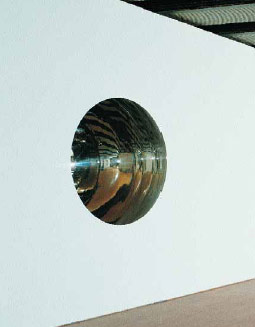 3. DELHI 3. DELHI
Iris
1998,
stainless steel,
200 x 200 x 200 cm
Illusion is central to Kapoor’s work. Just as the
painted void can make stone seem to disappear,
Kapoor’s mirrored objects use reflections to
camouflage themselves in their environment and
appear like holes in space. The supporting structure
of Iris is concealed, so the convex mirror emerges
effortlessly from the wall, like the eye as it
appears in the face (with the rest of the eyeball
secured invisibly in its socket). It indicates a
continuation beyond the wall into which it is set.
Iris is all-seeing: it reflects all its
surroundings, distorting and reproducing them in
miniature. The only place not visible is the patch
it is placed on, mimicking the fact that eye locates
the body in the world, but we can never truly see
ourselves. Like an inverted security mirror, Iris
has a destabilising effect.
4. MUMBAI
S-Curve
2006,
stainless steel,
216.5 x 975.4 x 121.9 cm
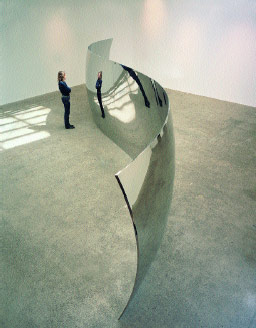 From a bird’s eye view, S-Curve mirrors the curl of
a question mark, and viewed straight-on, it
confounds expectations. As with the pigment pieces,
whose powder forms a kind of skin, so too the
surface of the polished steel has a life of its own,
different according to every exhibition space.
Nonetheless, the distortions follow a pattern. Light
travels in straight lines, and when it hits the
concave hollows images are swallowed and flipped
upside-down, while the convex bulges spit them back
again. This echoes the mathematical model of the
sculpture’s title, the sigmoid curve, where data is
characterised by rapid acceleration at its
mid-point. The suction between distortions also has
the effect of making the solid object take on a
liquid appearance. Unlike a hall of mirrors in a
circus, this sleek, free-standing unit does not
surround the viewer. Instead, it demands that the
viewer walks around it, following the direction of
the wave. Just taller than human height, it has a
commanding presence. From a bird’s eye view, S-Curve mirrors the curl of
a question mark, and viewed straight-on, it
confounds expectations. As with the pigment pieces,
whose powder forms a kind of skin, so too the
surface of the polished steel has a life of its own,
different according to every exhibition space.
Nonetheless, the distortions follow a pattern. Light
travels in straight lines, and when it hits the
concave hollows images are swallowed and flipped
upside-down, while the convex bulges spit them back
again. This echoes the mathematical model of the
sculpture’s title, the sigmoid curve, where data is
characterised by rapid acceleration at its
mid-point. The suction between distortions also has
the effect of making the solid object take on a
liquid appearance. Unlike a hall of mirrors in a
circus, this sleek, free-standing unit does not
surround the viewer. Instead, it demands that the
viewer walks around it, following the direction of
the wave. Just taller than human height, it has a
commanding presence.
5. DELHI
Past, Present, Future
2006,
wax and oil-based paint,
345 x 89 x 445 cm
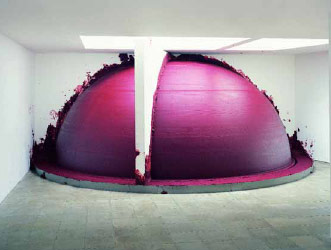 Where Iris and S-Curve question how we perceive
exterior space, Kapoor now asks us to consider
insides. If you close your eyes against the sun, you
will see an intense red glow through your eyelids.
From an eye-ball to the globe, in Past, Present,
Future Kapoor returns to the colour red – the colour
of flesh and blood, of India and indeed the earth.
After years of making highly finished sculptures,
this vast, messy piece is a bold gesture, using a
gory mixture of wax, paint, petroleum jelly and
thinners. Its form is created by its own movement: a
sphere is shaped by an arc that slowly swings
180-degrees. Just as the early pigment pieces
sprouted up from the floor, so too this grows within
the body of the building, and like the powder on the
floor, Past, Present, Future leaves traces of waxy
stuff on the arc and adjacent walls. Although the
working process seems to be on show, illusion is
still at play. As with Iris, it seems that only a
portion of the globe is visible, and it may only
appear to be solid red all the way through. Such
shapeshifting recalls Hindu mythology, where Gods
can get what they want by using magical powers to
change their identity. Where Iris and S-Curve question how we perceive
exterior space, Kapoor now asks us to consider
insides. If you close your eyes against the sun, you
will see an intense red glow through your eyelids.
From an eye-ball to the globe, in Past, Present,
Future Kapoor returns to the colour red – the colour
of flesh and blood, of India and indeed the earth.
After years of making highly finished sculptures,
this vast, messy piece is a bold gesture, using a
gory mixture of wax, paint, petroleum jelly and
thinners. Its form is created by its own movement: a
sphere is shaped by an arc that slowly swings
180-degrees. Just as the early pigment pieces
sprouted up from the floor, so too this grows within
the body of the building, and like the powder on the
floor, Past, Present, Future leaves traces of waxy
stuff on the arc and adjacent walls. Although the
working process seems to be on show, illusion is
still at play. As with Iris, it seems that only a
portion of the globe is visible, and it may only
appear to be solid red all the way through. Such
shapeshifting recalls Hindu mythology, where Gods
can get what they want by using magical powers to
change their identity.
6. DELHI
Laboratory for a New Model of the Universe
2007,
acrylic,
101.6 x 101.6 x 99.1 cm
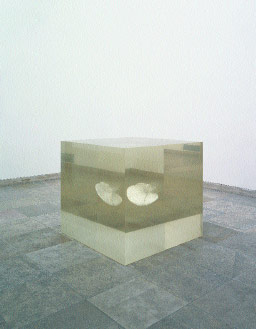 Kapoor presents us with what looks like a thought
bubble or a globule in a paperweight –
appropriately, as the Laboratory is addressing the
weight of human knowledge, from the grand purposes
of physics to the more specific concerns of art
history. Playing with the idea of utopia (from the
Greek, ‘no-place’), this model of the universe bears
no sign of the artist’s hand: the edges are clean
and the surfaces clinical. Kapoor has chosen to get
away from the traditional materials of sculpture
(stone, bronze, steel), and pursue the idea of the
immaterial by working with plastic. The moulding
process enables him to trap the air itself and turn
it into an object. In effect, the acrylic mould
forms a frame for empty space, making the invisible
visible. Whereas the internal construction of the
pigment pieces (from wood, plaster, or fibreglass)
is disguised by their painted and dusty surfaces,
the acrylic is transparent. It has nothing to hide,
yet it is still illusionary. Light is refracted as
it hits the denser medium, travelling more slowly
and bending, so viewed through the block, the floor
and surrounding walls appear to shift,
hallucinatory. Kapoor presents us with what looks like a thought
bubble or a globule in a paperweight –
appropriately, as the Laboratory is addressing the
weight of human knowledge, from the grand purposes
of physics to the more specific concerns of art
history. Playing with the idea of utopia (from the
Greek, ‘no-place’), this model of the universe bears
no sign of the artist’s hand: the edges are clean
and the surfaces clinical. Kapoor has chosen to get
away from the traditional materials of sculpture
(stone, bronze, steel), and pursue the idea of the
immaterial by working with plastic. The moulding
process enables him to trap the air itself and turn
it into an object. In effect, the acrylic mould
forms a frame for empty space, making the invisible
visible. Whereas the internal construction of the
pigment pieces (from wood, plaster, or fibreglass)
is disguised by their painted and dusty surfaces,
the acrylic is transparent. It has nothing to hide,
yet it is still illusionary. Light is refracted as
it hits the denser medium, travelling more slowly
and bending, so viewed through the block, the floor
and surrounding walls appear to shift,
hallucinatory.
7. MUMBAI
Non-Object (Spire)
2008,
stainless steel,
302.2 x 300 x 300 cm
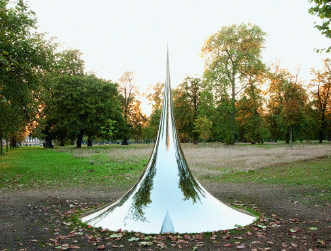 Like an upturned trumpet, the round base of this
sculpture sits flush with the ground. It points to
the sky, as if bring pulled up by an invisible
thread, and disappears to a peak no wider than a
pinprick. The perfectly smooth steel creates
reflections that appear to dissolve and flow into
the surroundings. Move nearer or further away and
the spire acts like a giant kaleidoscope, repeating
reflections. It creates its own mysterious, sweeping
landscape, and in this sense, as the name suggests,
the Non-Object has a life beyond its physical
structure. Kapoor is fascinated by the tension
between something that is clearly man-made, but
which means more than the sum of its parts: the
Buddhist idea of rupa (comprehension of form) is
weighed up against svayambh (the Sanskrit word for a
‘self-born’ aesthetic). Like an upturned trumpet, the round base of this
sculpture sits flush with the ground. It points to
the sky, as if bring pulled up by an invisible
thread, and disappears to a peak no wider than a
pinprick. The perfectly smooth steel creates
reflections that appear to dissolve and flow into
the surroundings. Move nearer or further away and
the spire acts like a giant kaleidoscope, repeating
reflections. It creates its own mysterious, sweeping
landscape, and in this sense, as the name suggests,
the Non-Object has a life beyond its physical
structure. Kapoor is fascinated by the tension
between something that is clearly man-made, but
which means more than the sum of its parts: the
Buddhist idea of rupa (comprehension of form) is
weighed up against svayambh (the Sanskrit word for a
‘self-born’ aesthetic).
8. MUMBAI
Shooting into the Corner
2008–9,
base frame, barrel, air-receivers,
compressor and airlines, projectiles
210 x 150 x 100 cm
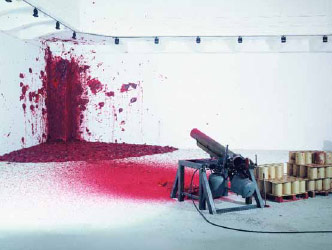 Kapoor is renowned for his immaculate style, whereby
the production processes are kept behind the scenes.
He prefers for the artist’s hand in the work to
remain invisible, and in Shooting into the Corner
that logic is extended. In terms of scale and
ambition, it exceeds its cousin, Past, Present,
Future as the creation of the artwork is fully
exposed – the process is part of the piece. An
operator mans the canon and shoots wax missiles into
the corner of the gallery; they describe the space
in-between with an urgent red line. On its first
display at the Royal Academy (London), Kapoor turned
the role of the gallery inside-out. The artist
authorised the audience to participate in warfare
with the institution. Officially the preserve of
calm observation, the place was filled with noise,
sensation and muck. The life of the piece was
recorded on the walls by its wax emissions; in this
way, Shooting into the Corner is impossible to
categorise as a single object, but as an active part
of the architecture. Tonnes of red wax will
accumulate in Mumbai’s Bollywood studios, a
spectacular setting for such filmic blood and guts. Kapoor is renowned for his immaculate style, whereby
the production processes are kept behind the scenes.
He prefers for the artist’s hand in the work to
remain invisible, and in Shooting into the Corner
that logic is extended. In terms of scale and
ambition, it exceeds its cousin, Past, Present,
Future as the creation of the artwork is fully
exposed – the process is part of the piece. An
operator mans the canon and shoots wax missiles into
the corner of the gallery; they describe the space
in-between with an urgent red line. On its first
display at the Royal Academy (London), Kapoor turned
the role of the gallery inside-out. The artist
authorised the audience to participate in warfare
with the institution. Officially the preserve of
calm observation, the place was filled with noise,
sensation and muck. The life of the piece was
recorded on the walls by its wax emissions; in this
way, Shooting into the Corner is impossible to
categorise as a single object, but as an active part
of the architecture. Tonnes of red wax will
accumulate in Mumbai’s Bollywood studios, a
spectacular setting for such filmic blood and guts.
9. DELHI
Sky Mirror
2010,
stainless steel,
275 x 290 x 146.8 cm
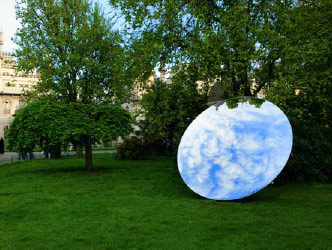 Mounted at a 60-degree angle from the ground, the
tilt of the massive Sky Mirror is unlikely. There is
magic in its engineering. (On leaving school, Kapoor
had tried six months of an engineering course in
Israel before devoting himself to art; professional
engineers make a vital contribution to his
practice). Although huge and fixed, Sky Mirror
appears ephemeral and dynamic due to the
ever-changing reflections across its surface. The
concave side of the mirror is facing up, and like an
inverted satellite dish, receives images of the sky
and beams them back heavenwards. At the same time,
to us earthlings, the reflections appear
upside-down. Modern physics teaches that space is
full of holes, where space, time and gravity are
inconceivably distorted. Sky Mirror serves as an
earth-bound black hole. It disrupts our perception
of gravity: things go up, but they don’t come down. Mounted at a 60-degree angle from the ground, the
tilt of the massive Sky Mirror is unlikely. There is
magic in its engineering. (On leaving school, Kapoor
had tried six months of an engineering course in
Israel before devoting himself to art; professional
engineers make a vital contribution to his
practice). Although huge and fixed, Sky Mirror
appears ephemeral and dynamic due to the
ever-changing reflections across its surface. The
concave side of the mirror is facing up, and like an
inverted satellite dish, receives images of the sky
and beams them back heavenwards. At the same time,
to us earthlings, the reflections appear
upside-down. Modern physics teaches that space is
full of holes, where space, time and gravity are
inconceivably distorted. Sky Mirror serves as an
earth-bound black hole. It disrupts our perception
of gravity: things go up, but they don’t come down.
10. DELHI
Untitled
2010,
fibreglass and pigment,
300 x 300 cm
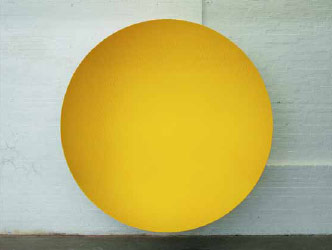 Alongside increasingly large-scale public projects,
repetition fulfils a kind of meditative role for
Kapoor. This recent piece loops back to the early
pigment works. A round fibreglass bowl is fixed low
on the wall. From a side angle, shadow tricks the
eye into imagining a convex form, whereas approached
straight-on, the bowl envelops the viewer’s field of
vision. The cavity is filled with yellow pigment,
sprayed all over for a perfectly even expanse in
which to lose sense of the bowl’s proportions as an
object. The swathe of colour acts as something of a
magic circle, or Mandala: focus is found through
looking. Alongside increasingly large-scale public projects,
repetition fulfils a kind of meditative role for
Kapoor. This recent piece loops back to the early
pigment works. A round fibreglass bowl is fixed low
on the wall. From a side angle, shadow tricks the
eye into imagining a convex form, whereas approached
straight-on, the bowl envelops the viewer’s field of
vision. The cavity is filled with yellow pigment,
sprayed all over for a perfectly even expanse in
which to lose sense of the bowl’s proportions as an
object. The swathe of colour acts as something of a
magic circle, or Mandala: focus is found through
looking.
Yellow, a primary colour, cannot be defined in terms
of a mixture of other pigments. It is insistently
itself. The effect of this pure colour is as heady
as Indian ‘puree’, while its cavity evokes that most
English of flowers, the daffodil’s trumpet – even
so, the void submerges any single association.
Kapoor originally came to England in order to be an
artist, and as an artist he looks far afield.
11. DELHI
Architectural models
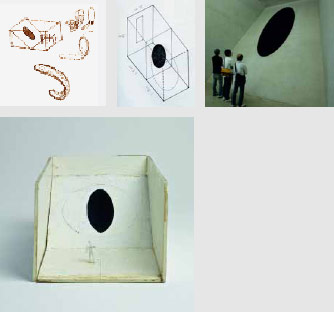 This group of drawings and models surveys Kapoor’s
collaborations with architects and engineers from
throughout his career, alongside future projects.
They offer a rare insight into the development of
his ideas. Kapoor’s work is always about the human
relationship with the space he creates – or
destroys. For him, many of these architectural
pieces are about the making of emptiness or the
expansion of available space. He talks of his desire
to make space ‘unreadable’, and while none of these
works are pure sculpture, nor are they purely
architectural. Each explores the ‘fiction of space’
through conceptual engagement with buildings. This group of drawings and models surveys Kapoor’s
collaborations with architects and engineers from
throughout his career, alongside future projects.
They offer a rare insight into the development of
his ideas. Kapoor’s work is always about the human
relationship with the space he creates – or
destroys. For him, many of these architectural
pieces are about the making of emptiness or the
expansion of available space. He talks of his desire
to make space ‘unreadable’, and while none of these
works are pure sculpture, nor are they purely
architectural. Each explores the ‘fiction of space’
through conceptual engagement with buildings.
Models range from the simplest example, Place
(1982), a wall with a hole in it, through to
Tarantantara (1999–2000), where Kapoor aimed to turn
shell of a former mill-cum-gallery inside-out by
filling it with a membrane form, which had a
rectangular opening at one end morphing to a
circular one at the other. The models show how vital
scale is to the artist’s work. The spiritual
dimensions associated with his sculptures are
intensely concentrated in the miniature maquettes.
These are the kernels of epic schemes, and a sense
of the shift in scale is provided by the sculptures
in the adjacent galleries.
Biography
Anish Kapoor
Anish Kapoor was born in Bombay in 1954 and left
India in 1973 when he studied at Hornsey College of
Art and Chelsea School of Art Design. He is widely
regarded as one of the world’s most distinguished
and significant contemporary artists.
One of the world's most distinguished contemporary
artists, Turner Prize winning Anish Kapoor studied
in London, where he is now based. He is well known
for his use of rich pigment and imposing, yet
popular works, such as the vast, fleshy and
trumpet-like Marsyas, which filled the Tate's
Turbine Hall as part of the Unilever Series, the
giant reflecting, pod like sculpture Cloud Gate in
Chicago's Millennium Park and his recent record
breaking show at the Royal Academy, the most
successful exhibition ever presented by a
contemporary artist in London.
Over the past twenty years he has exhibited
extensively in London and all over the world. His
solo shows have included venues such as Kunsthalle
Basel, Tate Gallery and Hayward Gallery in London,
Reina Sofia in Madrid, CAPC in Bordeaux and most
recently Haus der Kunst in Munich. He has also
participated internationally in many group shows
including the Whitechapel Art Gallery, The Royal
Academy and Serpentine Gallery in London, Documenta
IX in Kassel, Moderna Museet in Stockholm and Jeu de
Paume and Centre Georges Pompidou in Paris.
Anish Kapoor was awarded the ‘Premio Duemila’ at the
Venice Biennale in 1990, the Turner Prize Award in
1991 and was awarded an Honorary Fellowship at the
London Institute in 1997 and a CBE in 2003. He is
represented by the Lisson Gallery, London, Barbara
Gladstone Gallery, New York and Galleria Continua
and Galleria Massimo Minini, Italy.
1954 - Born, Bombay, India
1977-78- Chelsea School of Art, London
1990 - Awarded ‘Premio Duemila’ at the Venice Biennale
1991 - Turner Prize Award
1997 - Awarded Honorary Doctorate at the London
Institute
2001 - Awarded an Honorary Fellowship at Royal
Institute of British Architecture
2003 - Awarded CBE.
2010 - Commissioned to Design Iconic Visitor
Attraction At Olympic Park
Anish Kapoor’s latest commission is to design the
spectacular new public attraction for London 2012
Olympic Park entitled ‘The ArcelorMittal Orbit’. The
Mayor of London Boris Johnson and the Olympics
Minister Tessa Jowell agreed the commission in
partnership with steel magnate Mr. Lakshmi Mittal.
The breathtaking sculpture that will be 22m taller
than the Statue of Liberty – thought to be the
tallest in the UK - will consist of a continuous
looping lattice of tubular steel.
|





